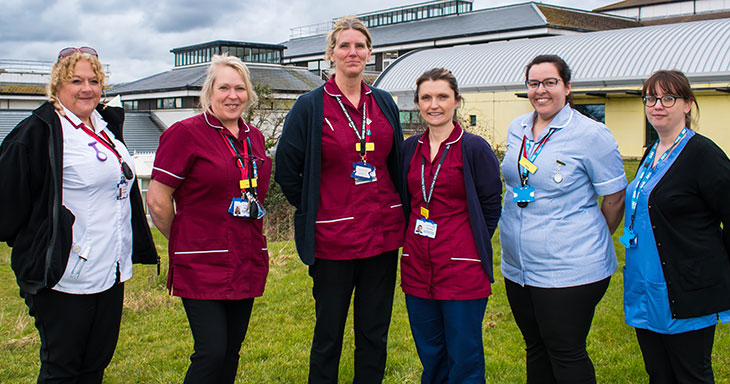
Sam Morley, Advanced Clinical Lead for Virtual Wards with members of the team
Since it launched in December, the trust’s virtual wards have seen more than 300 patients, providing a range of hospital-grade services to patients in the comfort of their own home.
We caught up with Sam Morley, the Advanced Clinical Lead for Virtual Wards for the trust, to hear more about the service and how it’s making a difference to the way that patients experience their care.
“It’s about providing the care that a patient would ordinarily expect in a hospital bed, but at home,” explains Sam. “It’s really that straightforward. Monitoring of vitals like blood pressure, heart rate and oxygen levels, administering IV antibiotics. We can’t do things like x-rays, but for the big cohort of patients that need routine monitoring and treatment and would normally have had to stay in a hospital bed for it, it’s made a real difference.”
The range of patients that this covers is substantial, with the team having dedicated, consultant-led virtual wards for patients with heart failure, respiratory illnesses and in need of frailty care. A GP-led ‘general’ virtual ward looks after a wide range of patients with other conditions, often referred in directly by GPs or our own urgent critical response team and avoiding the need for them to come into hospital at all. The team are even able to provide care directly for some of those who have had falls, providing a physical assessment in situ, then monitoring, medication and follow-up – all without the patient needing to go to hospital.
Visits by the virtual ward team can be scaled up and down according to the clinical needs of the patients, so the levels of support are personalised to the level that the individual patient needs. “We might visit three or four times a day for our high intensity patients who need a lot of clinical support,” says Sam, “but for the low intensity patients, it can be less than daily. That’s when the remote monitoring really comes into its own.”
The remote monitoring system utilises a wearable monitor, that records patient clinical information and transmits it back to the trust for review. The system comes with an iPad, where patients can contact the team directly by text or video if they feel unwell and need to talk to a clinician – just like they would press a call bell in a hospital bed.
But if someone is unwell, wouldn’t they be better off in a hospital bed? In fact, for these patients the opposite is true. “There are so many benefits to patient health and wellbeing through being cared for at home,” explains Sam. “They can eat their usual diet and they normally sleep better in their own bed than on a shared ward. Being able to use their own loo, with that extra privacy and comfort, means they’re less likely to become constipated. Patients with dementia experience less disruption to their routines, so it can make a very big difference to their mental health. Family and friends can drop in easily and for those patients who live with their families, they can continue to have their family life without too much disruption. It all adds up to a really big improvement to their mental health and overall wellbeing.”
One patient was even able to keep up with the day-to-day running of the family business. “This gentleman needed regular IV antibiotics, but he was running the family business and couldn’t be away for long periods of time. Rather than having to close while he was having hospital treatment, we were able to arrange to visit him at work and provide treatment there on site. He got the clinical care he needed, without needing to stop living his life,” says Sam. “That’s really what virtual wards is all about.”
